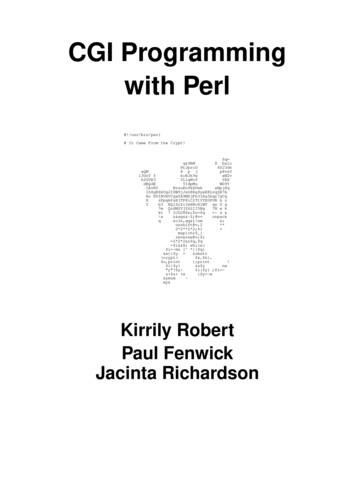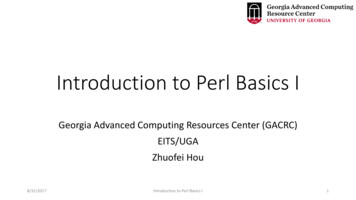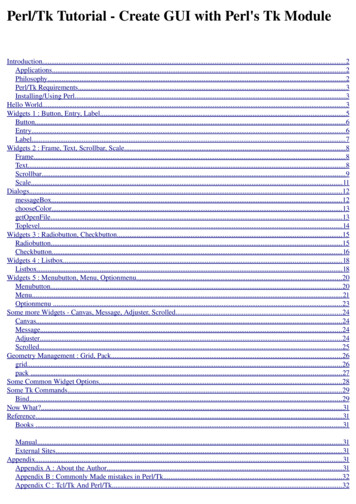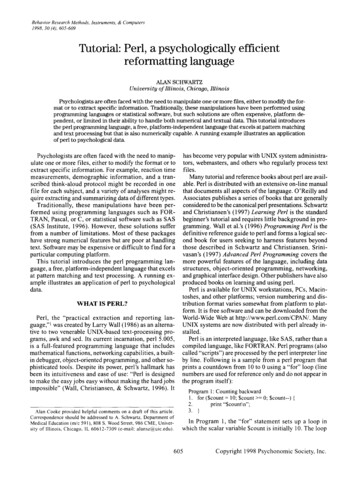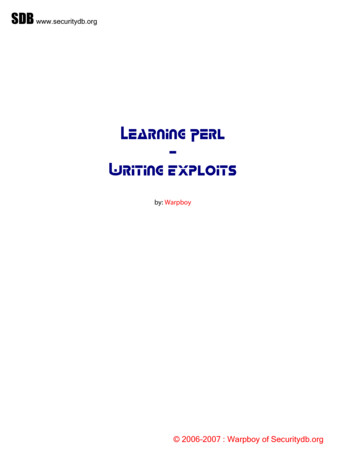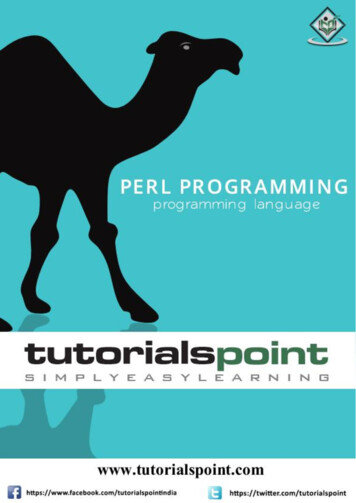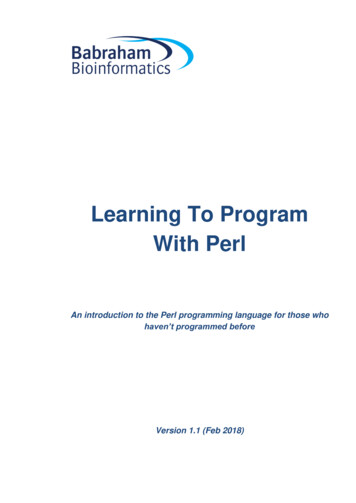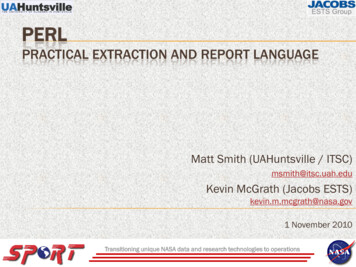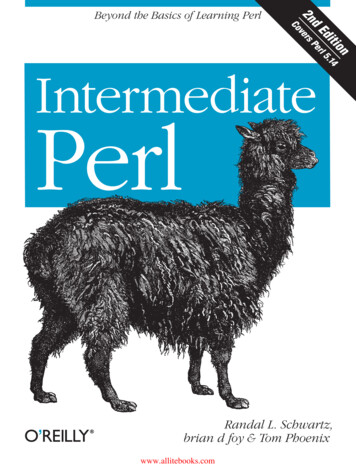
Transcription
www.allitebooks.com
www.allitebooks.com
SECOND EDITIONIntermediate PerlRandal L. Schwartz, brian d foy, and Tom PhoenixBeijing Cambridge Farnham Köln Sebastopol Tokyowww.allitebooks.com
Intermediate Perl, Second Editionby Randal L. Schwartz, brian d foy, and Tom PhoenixCopyright 2012 Randal Schwartz, brian d foy, Tom Phoenix. All rights reserved.Printed in the United States of America.Published by O’Reilly Media, Inc., 1005 Gravenstein Highway North, Sebastopol, CA 95472.O’Reilly books may be purchased for educational, business, or sales promotional use. Online editionsare also available for most titles (http://my.safaribooksonline.com). For more information, contact ourcorporate/institutional sales department: 800-998-9938 or corporate@oreilly.com.Editors: Simon St. Laurent and Shawn WallaceProduction Editor: Kristen BorgCopyeditor: Absolute Service, Inc.Proofreader: Absolute Service, Inc.March 2006:August 2012:Indexer: Lucie HaskinsCover Designer: Karen MontgomeryInterior Designer: David FutatoIllustrator: Rebecca DemarestFirst Edition.Second Edition.Revision History for the Second Edition:2012-07-20First releaseSee http://oreilly.com/catalog/errata.csp?isbn 9781449393090 for release details.Nutshell Handbook, the Nutshell Handbook logo, and the O’Reilly logo are registered trademarks ofO’Reilly Media, Inc. Intermediate Perl, the image of an alpaca, and related trade dress are trademarks ofO’Reilly Media, Inc.Many of the designations used by manufacturers and sellers to distinguish their products are claimed astrademarks. Where those designations appear in this book, and O’Reilly Media, Inc., was aware of atrademark claim, the designations have been printed in caps or initial caps.While every precaution has been taken in the preparation of this book, the publisher and authors assumeno responsibility for errors or omissions, or for damages resulting from the use of the information contained herein.ISBN: m
Table of ContentsForeword . . . . . . . . . . . . . . . . . . . . . . . . . . . . . . . . . . . . . . . . . . . . . . . . . . . . . . . . . . . . . . . . . . . xiPreface . . . . . . . . . . . . . . . . . . . . . . . . . . . . . . . . . . . . . . . . . . . . . . . . . . . . . . . . . . . . . . . . . . . . xiii1. Introduction . . . . . . . . . . . . . . . . . . . . . . . . . . . . . . . . . . . . . . . . . . . . . . . . . . . . . . . . . . . 1What Should You Know Already?strict and warningsPerl v5.14A Note on VersionsWhat About All Those Footnotes?What’s With the Exercises?How to Get HelpWhat If I’m a Perl Course Instructor?Exercises2234445562. Using Modules . . . . . . . . . . . . . . . . . . . . . . . . . . . . . . . . . . . . . . . . . . . . . . . . . . . . . . . . . . 7The Standard DistributionExploring CPANUsing ModulesFunctional InterfacesSelecting What to ImportObject-Oriented InterfacesA More Typical Object-Oriented Module: Math::BigIntFancier Output with ModulesWhat’s in Core?The Comprehensive Perl Archive NetworkInstalling Modules from CPANCPANminusInstalling Modules ManuallySetting the Path at the Right TimeSetting the Path Outside the ks.com
Extending @INC with PERL5LIBExtending @INC on the Command Linelocal::libExercises212222233. Intermediate Foundations . . . . . . . . . . . . . . . . . . . . . . . . . . . . . . . . . . . . . . . . . . . . . . . 25List OperatorsList Filtering with grepTransforming Lists with mapTrapping Errors with evalDynamic Code with evalThe do BlockExercises252628293132334. Introduction to References . . . . . . . . . . . . . . . . . . . . . . . . . . . . . . . . . . . . . . . . . . . . . . 35Doing the Same Task on Many ArraysPeGS: Perl Graphical StructuresTaking a Reference to an ArrayDereferencing the Array ReferenceGetting Our Braces OffModifying the ArrayNested Data StructuresSimplifying Nested Element References with ArrowsReferences to HashesChecking Reference TypesExercises35373841424344454750525. References and Scoping . . . . . . . . . . . . . . . . . . . . . . . . . . . . . . . . . . . . . . . . . . . . . . . . . 53More than One Reference to DataWhat If That Was the Name?Reference Counting and Nested Data StructuresWhen Reference Counting Goes BadCreating an Anonymous Array DirectlyCreating an Anonymous HashAutovivificationAutovivification and HashesExercises5354555759616366686. Manipulating Complex Data Structures . . . . . . . . . . . . . . . . . . . . . . . . . . . . . . . . . . . . 71Using the Debugger to View Complex DataViewing Complex Data with Data::DumperOther DumpersMarshalling Dataiv Table of Contentswww.allitebooks.com71757778
Storing Complex Data with StorableYAMLJSONUsing the map and grep OperatorsApplying a Bit of IndirectionSelecting and Altering Complex DataExercises808585868688907. Subroutine References . . . . . . . . . . . . . . . . . . . . . . . . . . . . . . . . . . . . . . . . . . . . . . . . . . 91Referencing a Named SubroutineAnonymous SubroutinesCallbacksClosuresReturning a Subroutine from a SubroutineClosure Variables as InputsClosure Variables as Static Local Variablesstate VariablesFinding Out Who We AreEnchanting SubroutinesDumping ClosuresExercise919697981001031041051071081111128. Filehandle References . . . . . . . . . . . . . . . . . . . . . . . . . . . . . . . . . . . . . . . . . . . . . . . . . 115The Old WayThe Improved WayFilehandles to StringsProcessing Strings Line by LineCollections of FilehandlesIO::Handle and FriendsIO::FileIO::ScalarIO::TeeIO::PipeIO::Null and IO::InteractiveDirectory HandlesDirectory Handle 251261261279. Regular Expression References . . . . . . . . . . . . . . . . . . . . . . . . . . . . . . . . . . . . . . . . . . 129Before Regular Expression ReferencesPrecompiled PatternsRegular Expression OptionsApplying Regex References129131132132Table of Contents vwww.allitebooks.com
Regexes as ScalarsBuild Up Regular ExpressionsRegex-Creating ModulesUsing Common PatternsAssembling Regular ExpressionsExercises13313613713713914010. Practical Reference Tricks . . . . . . . . . . . . . . . . . . . . . . . . . . . . . . . . . . . . . . . . . . . . . . 141Fancier SortingSorting with IndicesSorting EfficientlyThe Schwartzian TransformMultilevel Sort with the Schwartzian TransformRecursively Defined DataBuilding Recursively Defined DataDisplaying Recursively Defined DataAvoiding RecursionThe Breadth-First 11. Building Larger Programs . . . . . . . . . . . . . . . . . . . . . . . . . . . . . . . . . . . . . . . . . . . . . . 159The Cure for the Common CodeInserting Code with evalUsing doUsing requireThe Problem of Namespace CollisionsPackages as Namespace SeparatorsScope of a Package DirectivePackages and LexicalsPackage BlocksExercises15916016116316416516716816917012. Creating Your Own Perl Distribution . . . . . . . . . . . . . . . . . . . . . . . . . . . . . . . . . . . . . 173Perl’s Two Build SystemsInside Makefile.PLInside Build.PLOur First Distributionh2xsModule::StarterCustom TemplatesInside Your Perl DistributionThe META FileAdding Additional Modulesvi Table of 8180181
Inside a ModulePlain Ol’ DocumentationPod Command ParagraphsPod ParagraphsPod Formatting CodesChecking the Pod FormatThe Module CodeModule Building SummaryCreating a Module::Build DistributionCreating a ExtUtils::Makemaker 918913. Introduction to Objects . . . . . . . . . . . . . . . . . . . . . . . . . . . . . . . . . . . . . . . . . . . . . . . . 191If We Could Talk to the Animals. . .Introducing the Method Invocation ArrowThe Extra Parameter of Method InvocationCalling a Second Method to Simplify ThingsA Few Notes About @ISAOverriding the MethodsStarting the Search from a Different PlaceThe SUPER Way of Doing ThingsWhat to Do with @Where We AreOur Barnyard 0314. Introduction to Testing . . . . . . . . . . . . . . . . . . . . . . . . . . . . . . . . . . . . . . . . . . . . . . . . 205Why Should We Test?The Perl Testing ProcessTest Anywhere ProtocolThe Art of TestingA Test ExampleThe Test HarnessThe Standard TestsChecking that Modules CompileThe Boilerplate TestsThe Pod TestsAdding Our First TestsMeasuring Our Test CoverageSubroutine CoverageStatement CoverageBranch CoverageConditional 221222Table of Contents viiwww.allitebooks.com
Exercises22215. Objects with Data . . . . . . . . . . . . . . . . . . . . . . . . . . . . . . . . . . . . . . . . . . . . . . . . . . . . . 225A Horse Is a Horse, of Course of Course—Or Is It?Invoking an Instance MethodAccessing the Instance DataHow to Build a HorseInheriting the ConstructorMaking a Method Work with Either Classes or InstancesAdding Parameters to a MethodMore Interesting InstancesA Horse of a Different ColorGetting Our Deposit BackDon’t Look Inside the BoxFaster Getters and SettersGetters that Double as SettersRestricting a Method to Class Only or Instance 623623716. Some Advanced Object Topics . . . . . . . . . . . . . . . . . . . . . . . . . . . . . . . . . . . . . . . . . . . 239UNIVERSAL MethodsTesting Our Objects for Good BehaviorThe Last ResortUsing AUTOLOAD for AccessorsCreating Getters and Setters More EasilyMultiple InheritanceExercises23924024224324424624717. Exporter . . . . . . . . . . . . . . . . . . . . . . . . . . . . . . . . . . . . . . . . . . . . . . . . . . . . . . . . . . . . . 249What use Is DoingImporting with Exporter@EXPORT and @EXPORT OKGrouping with %EXPORT TAGSCustom Import RoutinesExercises24925025125225425618. Object Destruction . . . . . . . . . . . . . . . . . . . . . . . . . . . . . . . . . . . . . . . . . . . . . . . . . . . . 257Cleaning Up After OurselvesNested Object DestructionBeating a Dead HorseIndirect Object NotationAdditional Instance Variables in SubclassesUsing Class Variablesviii Table of Contentswww.allitebooks.com257259262263265267
Weakening the ArgumentExercise26827019. Introduction to Moose . . . . . . . . . . . . . . . . . . . . . . . . . . . . . . . . . . . . . . . . . . . . . . . . . 273Making Animals with MooseRoles Instead of InheritanceDefault ValuesConstraining ValuesWrapping MethodsRead-Only AttributesImproving the Race HorseFurther StudyExercises27327627727827928128128328320. Advanced Testing . . . . . . . . . . . . . . . . . . . . . . . . . . . . . . . . . . . . . . . . . . . . . . . . . . . . . 285Skipping TestsTesting Object-Oriented FeaturesGrouping TestsTesting Large StringsTesting FilesTesting STDOUT or STDERRUsing Mock ObjectsWriting Our Own Test::* ModulesExercises28528628728828929029229429721. Contributing to CPAN . . . . . . . . . . . . . . . . . . . . . . . . . . . . . . . . . . . . . . . . . . . . . . . . . . 299The Comprehensive Perl Archive NetworkGetting PreparedHow PAUSE WorksThe IndexerModule MaintainersBefore We Start WorkPreparing the DistributionCreate or Update the READMECheck the Build FileUpdate the ManifestIncrease the Version StringTest the DistributionUploading the DistributionTesting on Multiple PlatformsAnnouncing the 6307307308308Table of Contents ix
Appendix: Answers to Exercises . . . . . . . . . . . . . . . . . . . . . . . . . . . . . . . . . . . . . . . . . . . . . . . 311Index of Modules in this Book . . . . . . . . . . . . . . . . . . . . . . . . . . . . . . . . . . . . . . . . . . . . . . . . 359Index . . . . . . . . . . . . . . . . . . . . . . . . . . . . . . . . . . . . . . . . . . . . . . . . . . . . . . . . . . . . . . . . . . . . . 363x Table of Contents
ForewordPerl’s object-oriented mechanism is classic prestidigitation. It takes a collection of Perl’sexisting non-OO features such as packages, references, hashes, arrays, subroutines,and modules, and then–with nothing up its sleeve–manages to conjure up fully functional objects, classes, and methods. Seemingly out of nowhere.That’s a great trick. It means you can build on your existing Perl knowledge and easeyour way into OO Perl development, without first needing to conquer a mountain ofnew syntax or navigate an ocean of new techniques. It also means you can progressivelyfine-tune OO Perl to meet your own needs, by selecting from the existing constructsthe one that best suits your task.But there’s a problem. Since Perl co-opts packages, references, hashes, arrays, subroutines, and modules as the basis of its OO mechanism, to use OO Perl you already needto understand packages, references, hashes, arrays, subroutines, and modules.And there’s the rub. The learning curve hasn’t been eliminated; it’s merely been pushedback half a dozen steps.So then: how are you going to learn everything you need to know about non-OO Perlso you can start to learn everything you need to know about OO Perl?This book is the answer. In the following pages, Randal draws on two decades of usingPerl, and four decades of watching Gilligan’s Island and Mr. Ed, to explain each of thecomponents of Perl that collectively underpin its OO features. And, better still, he thengoes on to show exactly how to combine those components to create useful classes andobjects.So if you still feel like Gilligan when it comes to Perl’s objects, references, and modules,this book is just what the Professor ordered.And that’s straight from the horse’s mouth.—Damian Conway, May 2003xi
PrefaceAlmost 20 years ago (nearly an eternity in Internet time), Randal Schwartz wrote thefirst edition of Learning Perl. In the intervening years, Perl itself has grown substantiallyfrom a “cool” scripting language used primarily by Unix system administrators to arobust object-oriented programming language that runs on practically every computingplatform known to mankind, and maybe some that aren’t.Throughout its six editions, Learning Perl remained about the same size, around 300pages, and continued to cover much of the same material to remain compact and accessible to the beginning programmer. But there is much more to learn about Perl.Randal called the first edition of this book Learning Perl Objects, References, and Modules, and we renamed its update Intermediate Perl, but we like to think of it as justLearning More Perl. This is the book that picks up where Learning Perl leaves off. Weshow how to use Perl to write larger programs.As in Learning Perl, we designed each chapter to be small enough to read in just anhour or so. Each chapter ends with a series of exercises to help you practice what you’vejust learned, and the answers are provided in the appendix for your reference. And, likeLearning Perl, we’ve developed the material in this book for use in a teachingenvironment.Unless we note otherwise, everything in this book applies equally well to Perl on anyplatform, whether that is Unix, Linux, Windows ActivePerl from ActiveState, Strawberry Perl, or any other modern implementation of Perl. To use this book you just needto be comfortable with the material in Learning Perl and have the ambition to go further.After you finish this book, you will have seen most of the core Perl language conceptsthat you’ll need. The next book in the series is Mastering Perl, which focuses on applyingwhat you already know to writing effective and robust Perl applications as well asmanaging the Perl software development life cycle.At any point in your Perl career, you should also have Programming Perl, the (mostly)definitive bible of the language.xiii
Structure of This BookThere are three major sections of this book. The first section deals with references,which are the keys to complex data structures as well as to object-oriented programming. The second section introduces objects and how Perl implements object-orientedprogramming. The third and last section deals with Perl’s module structure, testing,and the community infrastructure for distributing our work.You should read this book from front to back, stopping to do the exercises. Each chapterbuilds on preceding chapters, and we’ll assume that you know the material from thosechapters as we show new topics.Chapter 1, IntroductionAn introduction to the material.Chapter 2, Using ModulesUse Perl’s core modules as well as modules from other people. We’re going to showyou how to create your own modules later in the book, but until we do you canstill use modules you already have.Chapter 3, Intermediate FoundationsPick up some intermediate Perl skills you’ll need for the rest of the book.Chapter 4, Introduction to ReferencesIntroduce a level of redirection to allow the same code to operate on different setsof data.Chapter 5, References and ScopingLearn how Perl manages to keep track of pointers to data, and read an introductionto anonymous data structures and autovivification.Chapter 6, Manipulating Complex Data StructuresCreate, access, and print arbitrarily deep and nested data structures including arrays of arrays and hashes of hashes.Chapter 7, Subroutine ReferencesCapture behavior as an anonymous subroutine that you create dynamically andexecute later.Chapter 8, Filehandle ReferencesStore filehandles in scalar variables that you can easily pass around your programor store in data structures.Chapter 9, Regular Expression ReferencesCompile regular expressions without immediately applying them, and use them asbuilding blocks for larger patterns.Chapter 10, Practical Reference TricksSorting complex operations, the Schwartzian Transform, and working with recursively defined data.xiv Preface
Chapter 11, Building Larger ProgramsBuild larger programs by separating code into separate files and namespaces.Chapter 12, Creating Your Own Perl DistributionCreate a Perl distribution as your first step toward object-oriented programming.Chapter 13, Introduction to ObjectsWork with classes, method calls, inheritance, and overriding.Chapter 14, Introduction to TestingStart to test your modules so you find problems with the code as you create it.Chapter 15, Objects with DataAdd per instance data, including constructors, getters, and setters.Chapter 16, Some Advanced Object TopicsUse multiple inheritance, automatic methods, and references to filehandles.Chapter 17, ExporterHow use works, how we can decide what to export, and how we can create ourown import routines.Chapter 18, Object DestructionAdd behavior to an object that is going away, including object persistence.Chapter 19, Introduction to MooseMoose is an object framework available on CPAN.Chapter 20, Advanced TestingTest complex aspects of code and metacode things such as documentation andtest coverage.Chapter 21, Contributing to CPANShare your work with the world by uploading it to CPAN.Appendix, Exercise AnswersWhere to go to get answers.Conventions Used in This BookThe following typographic conventions are used in this book:Constant widthUsed for function names, module names, filenames, environment variables, codesnippets, and other literal textItalicsUsed for emphasis and for new terms where they are definedPreface xv
Using Code ExamplesThis book is here to help you get your job done. In general, you may use the code inthis book in your programs and documentation. You do not need to contact us forpermission unless you’re reproducing a significant portion of the code. For example,writing a program that uses several chunks of code from this book does not requirepermission. Selling or distributing a CD-ROM of examples from O’Reilly books doesrequire permission. Answering a question by citing this book and quoting examplecode does not require permission. Incorporating a significant amount of example codefrom this book into your product’s documentation does require permission.We appreciate, but do not require, attribution. An attribution usually includes the title,author, publisher, and ISBN. For example: “Intermediate Perl by Randal L. Schwartz,brian d foy, and Tom Phoenix. Copyright 2012 Randal L. Schwartz, brian d foy, andTom Phoenix, 978-1-449-39309-0.”If you feel your use of code examples falls outside fair use or the permission given above,feel free to contact us at permissions@oreilly.com.Safari Books OnlineSafari Books Online (www.safaribooksonline.com) is an on-demand digitallibrary that delivers expert content in both book and video form from theworld’s leading authors in technology and business.Technology professionals, software developers, web designers, and business and creative professionals use Safari Books Online as their primary resource for research,problem solving, learning, and certification training.Safari Books Online offers a range of product mixes and pricing programs for organizations, government agencies, and individuals. Subscribers have access to thousandsof books, training videos, and prepublication manuscripts in one fully searchable database from publishers like O’Reilly Media, Prentice Hall Professional, Addison-WesleyProfessional, Microsoft Press, Sams, Que, Peachpit Press, Focal Press, Cisco Press, JohnWiley & Sons, Syngress, Morgan Kaufmann, IBM Redbooks, Packt, Adobe Press, FTPress, Apress, Manning, New Riders, McGraw-Hill, Jones & Bartlett, Course Technology, and dozens more. For more information about Safari Books Online, please visitus online.How to Contact UsPlease address comments and questions concerning this book to the publisher:O’Reilly Media, Inc.1005 Gravenstein Highway NorthSebastopol, CA 95472xvi Preface
800-998-9938 (in the United States or Canada)707-829-0515 (international or local)707-829-0104 (fax)We have a web page for this book where we list errata, examples, and any additionalinformation. You can access this page at:http://oreil.ly/int-perl-2eTo comment or ask technical questions about this book, send an email to:bookquestions@oreilly.comFor more information about our books, courses, conferences, and news, see our websiteat http://www.oreilly.com.Find us on Facebook: http://facebook.com/oreillyFollow us on Twitter: http://twitter.com/oreillymediaWatch us on YouTube: From Randal. In the preface of the first edition of Learning Perl, I acknowledged theBeaverton McMenamin’s Cedar Hills Pub1 just down the street from my house for the“rent-free booth-office space” while I wrote most of the draft on my Powerbook 140.Well, like wearing your lucky socks every day when your favorite team is in the playoffs,I wrote nearly all of this book (including these words) at the same brewpub, in hopesthat the light of success of the first book will shine on me twice. (As I update this prefacefor the second edition, I can see that my lucky socks do indeed work!)This McM’s has the same great local microbrew beer and greasy sandwiches, butthey’ve gotten rid of my favorite pizza bread, replacing it with new items likemarionberry cobbler (a local treat) and spicy jambalaya. (And they added two booths,and put in some pool tables.) Also, instead of the Powerbook 140, I’m using a TitaniumPowerbook, with 1,000 times more disk space, 500 times more memory, and a 200times-faster CPU running a real Unix-based operating system (OS X) instead of thelimited MacOS. I also uploaded all of the draft sections (including this one) over my144K cell-phone modem and emailed them directly to the reviewers, instead of havingto wait to rush home to my 9600-baud external modem and phone line. How timeshave changed!So, thanks once again to the staff of the McMenamin’s Cedar Hills Pub for the boothspace and the hospitality.1. http://www.mcmenamins.com/Preface xvii
Like the previous editions of Learning Perl, I also owe much of what I’m saying hereand how I’m saying it to the students of Stonehenge Consulting Services who have givenme immediate and precise feedback (by their glazed eyes and awkwardly constructedquestions) when I was exceeding the “huh?” factor threshold. With that feedback overmany dozens of presentations, I was able to keep refining and refactoring the materialsthat paved the way for this book.Speaking of which, those materials started as a half-day “What’s new in Perl 5?” summary commissioned by Margie Levine of Silicon Graphics, in addition to my frequentlypresented onsite four-day Llama course (targeted primarily for Perl Version 4 at thetime). Eventually, I got the idea to beef up those notes into a full course and enlistedfellow Stonehenge presenter Joseph Hall for the task. (He’s the one that selected theuniverse from which the examples are drawn.) Joseph developed a two-day course forStonehenge in parallel with his excellent Effective Perl Programming book (AddisonWesley Professional), which we then used as the course textbook (until now).Other Stonehenge instructors have also dabbled a bit in the “Packages, References,Objects, and Modules” course over the years, including Chip Salzenberg and TadMcClellan. But the bulk of the recent changes have been the responsibility of my seniortrainer Tom Phoenix, who has been “Stonehenge employee of the month” so often thatI may have to finally give up my preferred parking space.Tom Phoenix contributed most exercises in this book and a timely set of review notesduring my writing process, including entire paragraphs for me to just insert in place ofthe drivel I had written. We work well as a team, both in the classroom and in our jointwriting efforts. It is for this effort that we’ve acknowledged Tom as a coauthor, but I’lltake direct blame for any parts of the book you end up hating; none of that could havepossibly been Tom’s fault.And last but not least, a special thanks to brian d foy, who shepherded this book intoits second revision, and wrote most of the changes between the previous edition andthis edition.A book is nothing without a subject and a distribution channel, and for that I mustacknowledge longtime associates Larry Wall and Tim O’Reilly. Thanks guys, for creating an industry that has paid for my essentials, discretionary purchases, and dreamsfor nearly 20 years.And, as always, a special thanks to Lyle and Jack for teaching me nearly everything Iknow about writing and convincing me that I was much more than a programmer whomight learn to write; I was also a writer who happened to know how to program. Thankyou.And to you, the reader of this book, for whom I toiled away the countless hours whilesipping a cold microbrew and scarfing down a piece of incredible cheesecake, trying toavoid spilling on my laptop keyboard: thank you for reading what I’ve written. Ixviii Prefacewww.allitebooks.com
sincerely hope I’ve contributed (in at least a small way) to your Perl proficiency. If youever meet me on the street, please say hi.2 I’d like that. Thank you.From brian. I have to thank Randal first, since I learned Perl from the first edition ofLearning Perl, and learned the rest teaching the Llama and Alpaca courses for Stonehenge Consulting. Teaching is often the best way to learn.The most thanks has to go to the Perl community, the wonderfully rich and diversegroup of people who have made it a pleasure to work with the language and make thetools, websites, and modules that make Perl so useful. Many people have contributedindirectly to this book through my other work and discussions with them. There aretoo many to list, but if you’ve ever done anything with Perl with me, there’s probablya little of you in this book.From Tom. First of all, thanks to the entire team at O'Reilly for helping us to bring thisbook to fruition.Thanks to my Stonehenge coworkers and the students I've worked with over the years,and the people I've assisted on Usenet. Your ideas and suggestions have greatly improved this material.Especially deep thanks to my coauthor Randal for giving me freedom to explore teaching this material in varied ways.To my wife Jenna Padbury, thanks for being a cat person, and everything thereafter.From all of us. Thanks to our reviewers for providing comments on the draft of thisbook. Tom Christiansen did an amazing job not only correcting every technical problem he found, but also improving our writing quite a bit. This book is much better forit. David Golden, a fellow PAUSE admin and CPAN toolchain hacker, helped quite abit in straightening out the details of the module release process. Several of the Moosecrowd, including Stevan Little, Curtis “Ovid” Poe, and Jesse Luehrs, kindly helped withthat chapter. Sawyer X, the current maintainer of Module::Starter, helped tremendously as we developed those parts of the book.Thanks also to our many students who have let us know what parts of the coursematerial have needed improvement over the years. It’s because of you that we’re all soproud of it today.Thanks to the many Perl Mongers who have made us feel at home as we’ve visited yourcities. Let’s do it again sometime.And finally, our sincerest thanks to our friend Larry Wall, for having the wisdom toshare his really cool and powerful toys with the rest of the world so that we can all getour work done just a little bit faster, easier, and with more fun.2. And yes, you can ask a Perl question at the same time. I don’t mind.Preface xix
CHAPTER 1IntroductionWelcome to the next step in your understanding of Perl. You’re probably here eitherbecause you want to learn to write programs that are more than 100 lines long orbecause your boss has told you to do so.Our Learning Perl book was great because it introduced the use of Perl for short andmedium programs (which is most of the programming done in Perl, we’ve observed).But, to keep “the Llama book” from being big and intimidating, we deliberately andcarefully left a lot of information out.In the pages that follow, you can get “the rest of the story” in the same style as ourfriendly Llama book. It covers what you need to write programs that are 100 to 10,000(or even longer) lines
SECOND EDITION Intermediate Perl Randal L. Schwartz, brian d foy, and Tom Phoenix . Throughout its six editions, Learning Perl remained about the same size, around 300 pages, and continued to cover much of the same material to remain compact and ac-cessible to the beginning programmer. But there is much more to learn about Perl.
